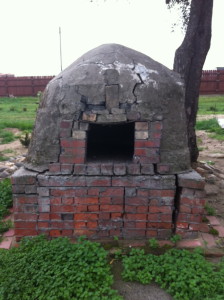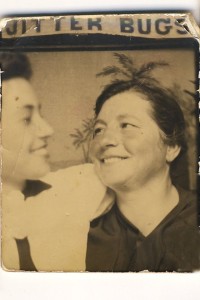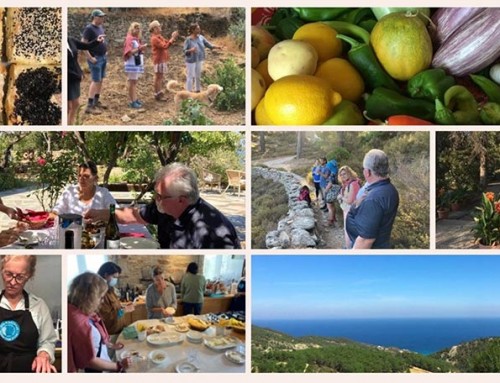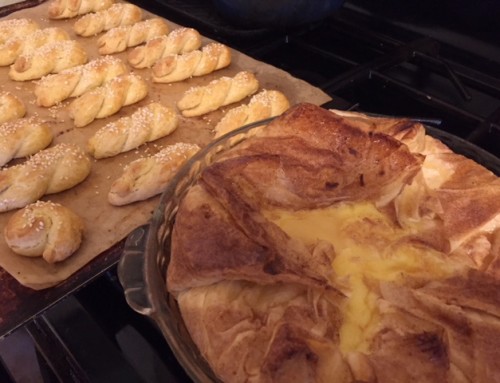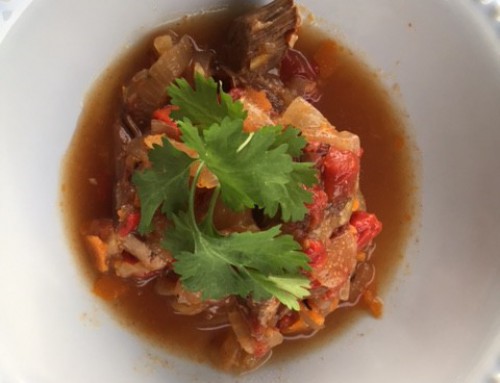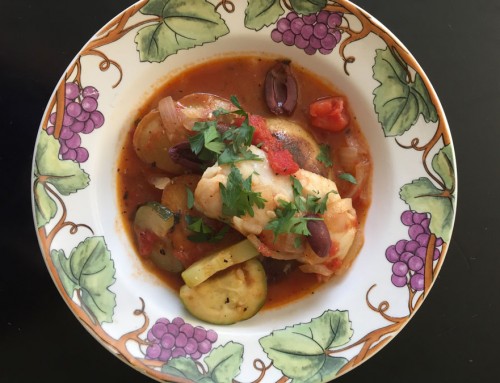This picture is of one of my favorite ovens EVER! This charming dome structure which was probably built sometime in the late 1930’s was the primary bread baking oven for my mother’s family. My mother’s family emigrated from Crete, Greece around the 1900’s and eventually landed in Manteca, CA where they purchased forty acres. Once they settled at the farm they began to fill it with all the things they remembered from their village in Crete. They built a cement plaza under the mulberry tree for singing, dancing, and feasting. In addition to an olive oil press my grandfather built this oven for my grandmother to bake her bread.
Mondays were bread baking days. It was almost an all day job so my Yiayia made sure to make enough bread to last the whole week and welcomed any hands, large or small to help. Yiayia began by proofing the yeast in some warm water with a pinch of sugar. While the yeast proofed she’d place a large pot of milk on the stove and heat it to just under scalding. After the milk had scalded she waited for it to be cool enough to proceed. The way she determined if the milk was ready was to hold her little finger in the pot and count to ten, if she could keep her finger in the milk for a count of ten without it burning her then she knew she could proceed. Next she’d pour the warm milk into a large metal kind of trough. She’d pour a generous amount of honey into the warm milk and season it with spices-coriander and cumin seeds crushed coarsely with against the palms of her hands, and several nuggets of masticha a sharp tasting tree resin that she had ground in a mortar and pestle. A handful of salt was tossed in and the yeast was added. If they hens had been busy that week and there were extra eggs, then some beaten eggs would go in, if there was butter around then a cube or two of butter might be added, it all depended on what needed to be used up. At this point she would start to add the flour, one hand stirring the dough while the other added the flour. She would stop when the dough still seemed quite wet and sticky. Because she was making such a large quantity she would mound flour on her work table and place a hunk of the soft sticky dough on the flour. She’d use flour to clean her hands of the sticky dough and then knead the whole mass, incorporating flour as necessary until the unruly mixture became lovely and silken. The kneaded dough would be placed in an oiled vessel roughly the same size as the one she’d made the dough in. She’d repeat this procedure until all the dough was beautiful, softly yielding and live. Anyone in the kitchen at the time would find themselves washing their hands and pitching in during this process. If we were too little to really be of any help she’d give us pieces of dough to keep ourselves amused while she worked. No matter how filthy or squashed our little loaves may have been she’d bake them with the same respect as she had for the family loaves. The whole lot of it was covered with clean tea towels and left to rise-the rising time would depend on the time of year and the temperature of the kitchen. Once the kitchen smelled of yeast and spices and the dough was tripled in size she’d punch the dough down, this was a task that had little volunteers begging to participate! To this day I love the sound of the air escaping as you punch into the big yeasty ball and how the soft warm dough feels beneath your hands as you knead it back into shape. Once all the dough had been disturbed from its yeasty slumber and reshaped it was allowed to “rest” again, for a shorter rise. While the dough was rising the oven was prepared.
The oven looked like a tall brick igloo. The opening was about two foot square and there was a hole at the top for smoke to escape. Big chunks of dried wood were placed in a pile in the middle of the clay domed oven dotted with kindling and set fire to. The wood would burn until most of the flame had subsided and the residual was hot and glowing. Eleven round cake pans were brushed with olive oil. The trough of dough was cut into eleven even pieces and shaped into rounds. Each round was slashed in an “x” pattern, the pans were placed close together and covered with a tea towel for their final rest. Once covered the bread was ceremoniously blessed with a wave of the hand doing the sign of the cross and a blessing muttered softly and with those good wishes it was left alone for another hour. Once ready to bake each loaf was brushed with an egg wash, eggs and water beaten together and gently brushed on each loaf with your fingers-no such thing as a pastry brush. At this point it was all hands on deck, every available adult and child would take a pan of perfectly risen dough and walk single file to the oven. My grandfather was concerned if the oven was too close to the house it could catch the farmhouse on fire, so this trek to the oven was always accompanied by a stream of quietly muttered Greek curses from my grandmother as she made her way towards the oven with her much beloved farm cats weaving their way in and out of her legs as she held a pan with one hand and tried to shoo them away with the other. Once we arrived at the oven the hot coals were brushed to the side of the oven and the pans of dough were layered in, bricks and metal racks creating levels to cook all the bread at once. Ironically the bread cooks rather quickly, the effort all being in the preparation and not the actual cooking. The baking required skill, the baker had to frequently squint to peer into the hot oven with temperatures upwards of 400 to rotate the pans making sure they browned evenly, in the summer it could be over 100 outside the oven and often you’d have to reach way back into the oven to tend to the bread. Once the bread was baked the whole family had to be in attendance again to carry the piping hot loaves back to the house…the trip back more treacherous complicated by trying not to burn yourself in addition to dodging cats and chickens.
One of my grandmother’s favorite phrases was “All the world waits for warm bread!”, and she was right, at least all of my childhood world, we LOVED the stuff. One or two loaves would be eaten immediately cut thick slathered with butter and drizzled with honey. No plate, no napkin, just big slabs of fragrant hot bread dripping butter and honey all over your face and hands. The remaining loaves were stacked on the counter to be used as the week progressed. Early in the week while the bread was still moist it could be used in sandwiches, but by the end of the week it was hard and dry and used for my grandmother’s favorite breakfast of dried bread softened in hot sugared coffee and milk in a large cereal bowl and eaten with a spoon.
I am so thrilled that the oven still stands and enjoys a place of prominence at the farm, nothing says family to me, or brings back such delicious memories as that rustic brick dome does.


